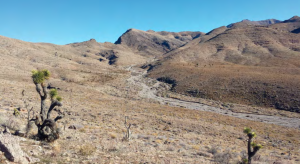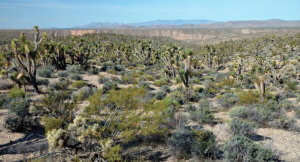
ST. GEORGE – Invasive grasses have dramatically changed the landscape in Southern Utah, intensifying wildfires and threatening desert habitats. The BLM is considering introducing three new herbicides to cut down on the problematic non-native vegetation.

Back in the mid- to late 1980s, fires happened less frequently and on a smaller scale, rarely growing to more than 50 acres in size, National Conservation Area manager Dawna Ferris-Rowley said.
“By the time we got into the 2005, 2006 years, fires were thousands of acres in size and you were having multiple fires,” Ferris-Rowley said.
“We’re seeing fire behavior that really experienced fire people have never seen before,” she said. A fire in the western part of Washington County raced nearly 5 miles in just a few minutes, she said.
“It was just like an instantaneous spread. That’s, I think, why most of the fire-fighting tactics have shifted to aircraft dropping retardant or water drops on these fires because they’re almost too dangerous to put crews or engines out there if the winds are really howling,” she said. “It’s a scary thing.”

Once the land burns, it becomes even more susceptible to invasive grasses which can lead to a cycle of repeated fires from which the land cannot recover.
Bigger and more frequent wildfires, fueled by non-native grasses, are one of the most significant problems caused by invasive plants in Washington County, Ferris-Rowley said.
Red brome, cheat grass and other species fuel fires in native landscapes that did not evolve to be fire adapted. Russian thistle, known as tumbleweeds, are also a problem, choking out native plants and accumulating along fence lines and in ditches.
Historically, wildfire was rare in the deserts of Southern Utah because not enough vegetation was produced by native plants to carry fire between shrubs and naturally fire-resistant species like creosote.
Wildfires destroyed about 25 percent of the tortoise habitat within the Red Cliffs and Beaver Dam Wash National Conservation Areas in 2005 and 2006, causing an approximately 50 percent drop in desert tortoise populations, according to the Utah Department of Wildlife Resources.
A research project is underway in those areas to determine the best way to plant native shrubs and grasses to restore fire-damaged desert tortoise habitat.
Read more: Habitat restoration project underway in fire-ravaged tortoise habitat
Three new herbicides proposed by the BLM for use on public lands may help land managers control invasive species and prevent catastrophic fires — aminopyralid, fluroxypyr, and rimsulfuron.

The Bureau of Land Management released a Final Programmatic Environmental Impact Statement April 7 for three new herbicides for use on BLM lands in 17 Western states. The impact statement examines the new herbicides that are considered safer for the environment and human health than those previously used.
A notice for the impact statement for the new vegetation treatments was published April 7 in the Federal Register and opened a 30-day review period on the document.
“One of the BLM’s highest priorities is to promote ecosystem health and one of the greatest obstacles to achieving this goal is the rapid expansion of weeds across public lands,” Mike Pool, acting Deputy Director of the BLM, said.
“The new vegetation treatments will give our public land managers a better set of tools to address wildfire protection, habitation restoration, and other resource issues more effectively.”
The study assesses three alternative approaches to the use of aminopyralid (known by the trade name Milestone), fluroxypyr (Vista), and rimsulfuron (Matrix), as well as a no action alternative that considers the continued use of 18 previously approved herbicides.
The final environmental impact study shows the expected impacts and benefits from the BLM’s use of herbicides and provides analysis to determine which herbicides should be approved for use.
The impact statement addresses a wide range of issues, including the effect of the herbicides on the health of humans, vegetation, fish and wildlife, livestock, and wild horses and burros. It also looks at water quality and Native American use of resources and evaluates the cumulative impact of using herbicides by the BLM and other landowners in the West.
The Programmatic Environmental Impact Statement can be found on this Web page.
The impact statement will be available for public review through May 6 and a Record of Decision will be issued following the 30-day review period.
Email: [email protected]
Twitter: @STGnews
Copyright St. George News, SaintGeorgeUtah.com LLC, 2016, all rights reserved.